this post was submitted on 07 Dec 2023
539 points (87.7% liked)
Asklemmy
43944 readers
767 users here now
A loosely moderated place to ask open-ended questions
If your post meets the following criteria, it's welcome here!
- Open-ended question
- Not offensive: at this point, we do not have the bandwidth to moderate overtly political discussions. Assume best intent and be excellent to each other.
- Not regarding using or support for Lemmy: context, see the list of support communities and tools for finding communities below
- Not ad nauseam inducing: please make sure it is a question that would be new to most members
- An actual topic of discussion
Looking for support?
Looking for a community?
- Lemmyverse: community search
- sub.rehab: maps old subreddits to fediverse options, marks official as such
- !lemmy411@lemmy.ca: a community for finding communities
~Icon~ ~by~ ~@Double_A@discuss.tchncs.de~
founded 5 years ago
MODERATORS
you are viewing a single comment's thread
view the rest of the comments
view the rest of the comments

Let me quote from the article:
"In mathematics, the distributive property of binary operations is a generalization of the distributive law, which asserts that the equality
x*(y+z) = x*y + x*zis always true in elementary algebra."This is the first sentence of the article, which clearly states that the distributive property is a generalization of the distributive law, which is then stated.
Make sure you can comprehend that before reading on.
To make your misunderstanding clear: You seem to be under the impression that the distributive law and distributive property are completely different statements, where the only difference in reality is that the distributive property is a property that some fields (or other structures with a pair of operations) may have, and the distributive law is the statement that common algebraic structures like the integers and the reals adhere to the distributive property.
I don't know which school you went to or teach at, but this certainly is not 7th year material.
Let me say again, people calling a Koala a Koala bear doesn't mean it actually is a bear. Stop reading wikipedia and pick up a Maths textbook.
It's not an impression, it's in Year 7 Maths textbooks.
And yet it appears in every Year 7 textbook I've ever seen.
Looks like we're done here.
If you don't want to see why you're wrong that's your thing, but I tried. I can just say, try to re-read the math textbook you took pictures of, and try to understand it.